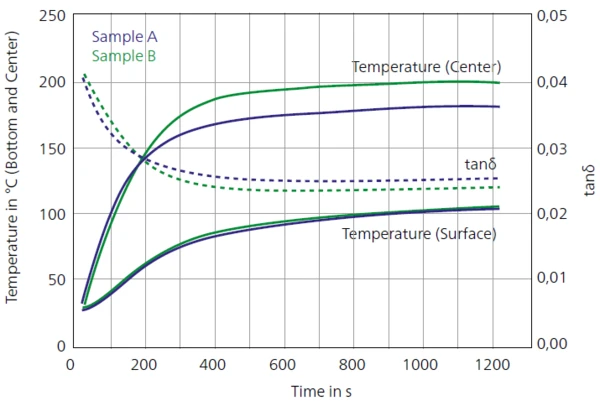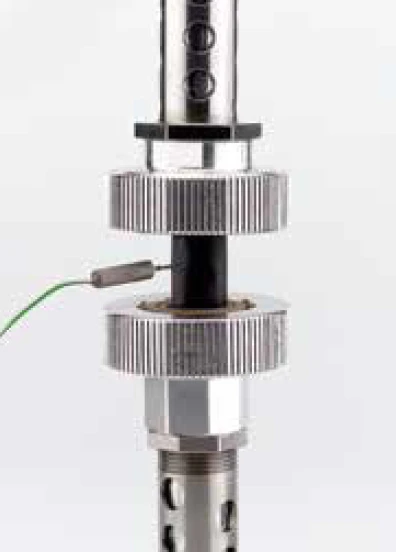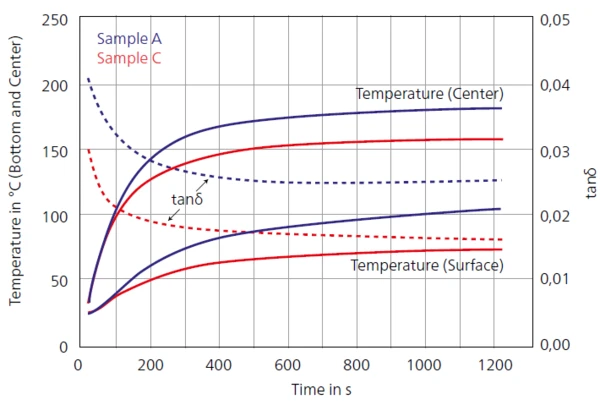Introduction
Dynamic heat build-up tests provide a better understanding of the thermal properties of elastomers. Such tests are carried out by applying a constant load, a frequency of 30 Hz and deformation amplitudes of several mm (according DIN 53 533 and ASTM D623-99). These test conditions result in internal friction, which in turn causes energy dissipation and thus an increase in sample temperature. Additionally, the sample undergoes deformation (thermal set). Heat build-up tests are relevant for tires/rubbers which are subject to high compressive StressStress is defined as a level of force applied on a sample with a well-defined cross section. (Stress = force/area). Samples having a circular or rectangular cross section can be compressed or stretched. Elastic materials like rubber can be stretched up to 5 to 10 times their original length.stress in service. The equipment qualified to perform such experiments is the GABOMETER®, which represents a modified Eplexor® system. It works as a more universal flexometer because it offers all of the features of the classical Goodrich Flexometer and additionally acquires mechanical material data such as the E modulus and damping (tanδ ).
A) Repeatability of Measurement Results
Since possible differences in the material constitution among the different specimen batches have to be distinguished among the different specimen batches, high repeatability in flexometer test results is essential. Figure 1 shows the repeatability test for GABOMETER® systems on two samples from the same batch.


Here, two test specimens (same batch – cylindrical samples for compression load) were tested independently, but under identical load conditions. The heat build-up results in differing temperatures; e.g., at the center versus at the surface. For temperature measurement an the center of the sample, a needle-shaped thermocouple is used, as displayed in figure 3.
The surface temperature measurement is performed at the upper surface of the sample via a thermocouple embedded in the thermally isolated upper heat build-up holder. The tanδ (material damping) measurement also exhibits excellent repeatability.

B) Benefits of Using an Additional Temperature Sensor (Needle Thermocouple)
Today, heat build-up tests are commonly performed with Goodrich Flexometers. However, conventional flexometers suffer from resolution and reproducibility problems. The modularity of the Eplexor® design includes configurations to perform heat build-up tests. The GABOMETER® is one of the most economic solutions dedicated to such HBU-Tests. The additional needle-shaped thermocouple for measuring the temperature at the sample’s center adds material information to the experiment that would otherwise remain hidden.
Measurement of a surface temperature is required by ASTM D623, but this alone does not always allow a distinction to be seen between two samples in terms of rising temperature as a function of time (see figure 2 – temperature at the surface). It is the additional needle-type temperature sensor that reveals the temperature at the core of the sample more precisely. The temperature at the center is the one least influenced by energy losses across outer surfaces. It is therefore also more sensitive for revealing temperature differenced induced by the heat build-up effect. Differences in the energy dissipation between samples A and B result in temperature differences which are most pronounced at the core. It is the core temperature measurement that allows for distinguishing between compounds A and B as shown in the example (figure 2).
But what is the reason for this difference?
The basic compounds of samples A and B are identical, but they differ in terms of the type of Carbon BlackTemperature and atmosphere (purge gas) affect the mass change results. By changing the atmosphere from, e.g., nitrogen to air during the TGA measurement, separation and quantification of additives, e.g., carbon black, and the bulk polymer can become possible.carbon black that they contain. The Carbon BlackTemperature and atmosphere (purge gas) affect the mass change results. By changing the atmosphere from, e.g., nitrogen to air during the TGA measurement, separation and quantification of additives, e.g., carbon black, and the bulk polymer can become possible.carbon black in sample A has a higher Thermal ConductivityThermal conductivity (λ with the unit W/(m•K)) describes the transport of energy – in the form of heat – through a body of mass as the result of a temperature gradient (see fig. 1). According to the second law of thermodynamics, heat always flows in the direction of the lower temperature.thermal conductivity and causes higher heat losses to the surface. As a result, the core temperature in case A declines more than in the lower-conductivity case B. The core temperature is reduced; the life cycle of the rubber compound is improved by a reduced heat dissipation.
C) Benefits of Recording tanδ
Figure 4 depicts another example of a heat build-up test. For this test, the very different compounds A and C were compared. Sample A exhibits a heat build-up which is of about 20°C higher than the corresponding temperature of sample C.
Consequently, the damping properties (tanδ) of the polymers are also quite different. Compound C reveals a much lower mechanical damping than compound A. Material C can better follow dynamical deformations than material A due to its lower mechanical damping losses (tanδ).

Conclusion
The Eplexor® 2000 N or 4000 N systems , as well as the universal GABOMETER® 2000 N and 4000 N flexometers, can be substituted for the classical Goodrich Flexometer in tests and generate additional advantages for the user. The optional needle thermocouple for core temperature measurements significantly improves the system’s sensitivity for detecting the heat build-up effect and is able to provide an enhanced picture of the material´s properties. Materials that are otherwise indistinguishable from one another in terms of heat build-up effect, can be reliably differentiated by using the needle.
In contrast, much less information is obtained when using only the surface temperature as per ASTM D623.
Thanks to their modular design, GABOMETER® systems can be upgraded in order to enable them to determine viscoelastic material properties or to obtain full DMTA functionality. Such retrofits can be carried out at any time after installation, as the need arises.